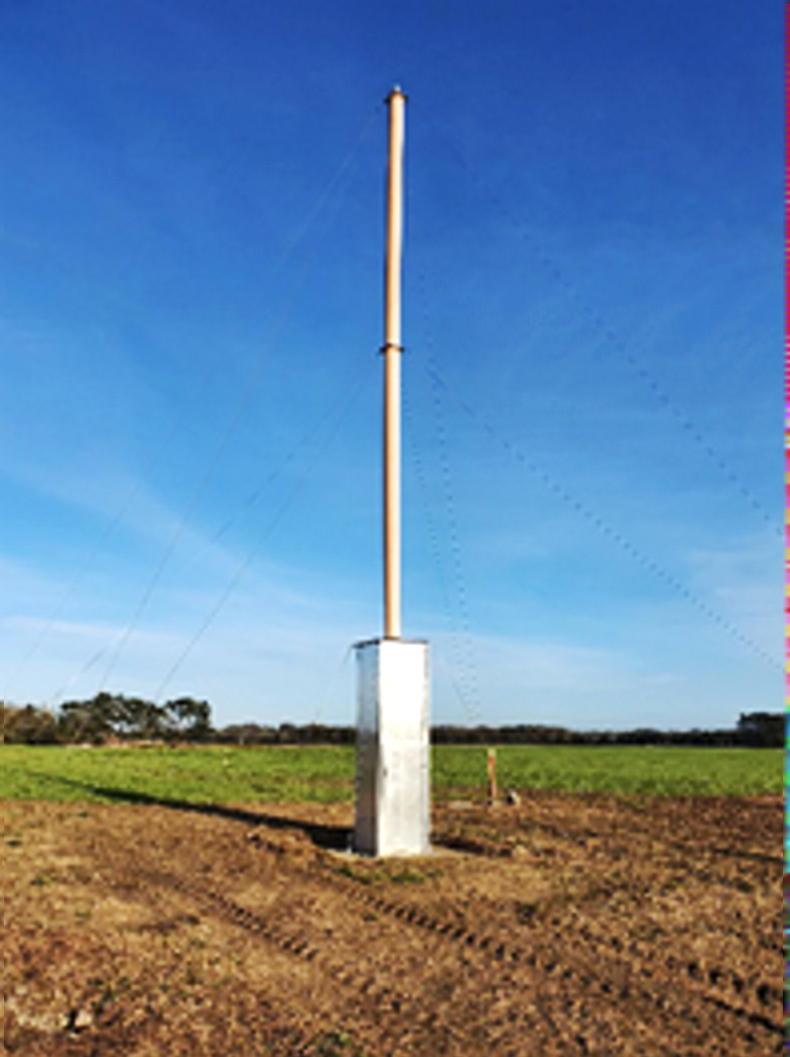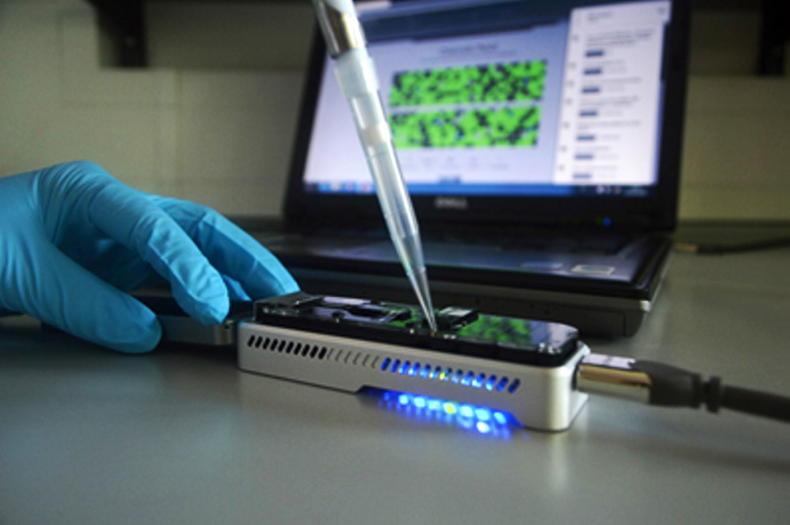Control of cereal aphids and the virus they vector, BYDV, has become more challenging in recent years due to the emergence of insecticide resistance and the loss of neonicotinoid seed treatments.
Teagasc’s new suction tower network, coupled with advanced diagnostics, aims to improve the information available when making decisions about insecticide application, or not.
Why this research
Currently, no thresholds exist for the control of aphids and BYDV in cereal fields. Because low numbers of aphids are capable of spreading the virus within a crop, the presence of aphids in a field is automatically considered a risk. We assume this without knowing the resistance status of the aphids or if they are carrying the virus.

One of the three large monitoring towers currently being evaluated by Teagasc for aphid and BYDV monitoring.
Furthermore, virus levels vary from field to field and across seasons, making it difficult to know when spray decisions are justified.
These challenges may be causing overuse of insecticides and this further increases the risk of insecticide resistance developing. This research will allow us to:
Understand the virus levels in migrating aphids. Identify time periods when virus-carrying aphids are most prominent. Associate aphid levels and virus status with the occurrence of BYDV in fields and resulting yields. Until now, virus testing only allowed us to determine the presence or absence of BYDV. Now, using new Droplet digital PCR (ddPCR) technology, we can quantify the level of virus in a sample. This will allow us to understand the dynamics of viruses spread by aphids, while also allowing us to determine the presence of BYDV in a plant. This can be done irrespective of whether there are visual symptoms or not.

Using the new droplet digital PCR (ddPCR) technology to detect virus at very low concentrations in either leaves or insects.
Suction towers for monitoring
Three 12.2m suction towers have been constructed in Oak Park, Ashtown and Cork.
Information about migrating aphids from each tower is representative of a zone of approximately 80km diameter around the tower. Aphids are collected daily in the suction towers and identified in the laboratory.
Then they undergo molecular analysis to detect BYDV and/or confirm insecticide resistance status.
Observations to date
Data from the Oak Park suction tower in 2020 found that the Bird Cherry-Oat Aphid, R. padi, was the most abundant migrating cereal aphid found and was present until the end of November.
In comparison, the grain aphid, S. avenae, was only found until the end of August. Aphid flight strongly increased at mean temperatures above 15°C and, as expected, strong winds and rain negatively affected aphid migration, as aphids cannot take off in unfavourable conditions.
In 2020, 22% of grain aphids recovered from the Oak Park suction tower tested positive for the gene mutation (kdr) that confers partial resistance to pyrethroids (see Figure 1).

Figure 1. Assessments in 2020 showing the breakdown of the aphid populations at Oak Park and Ashtown in terms of their relative susceptibility to pyrethroid insecticides.
This indicates that partially resistant aphids are still present in the population and capable of migrating large distances.
The next research step is to incorporate BYDV testing of migratory aphids, and to study the impact of different migrating aphids on the spread of BYDV.
Usefulness
Being able to combine the data from the suction tower network and our advanced diagnostic tools should enhance our understanding of BYDV risk and spread. This will improve our ability to advise on spray decisions to control aphids and BYDV in the future.
Furthermore, this tower platform allows us to monitor other insects of importance to growers in both the tillage and horticulture sectors.
Control of cereal aphids and the virus they vector, BYDV, has become more challenging in recent years due to the emergence of insecticide resistance and the loss of neonicotinoid seed treatments.
Teagasc’s new suction tower network, coupled with advanced diagnostics, aims to improve the information available when making decisions about insecticide application, or not.
Why this research
Currently, no thresholds exist for the control of aphids and BYDV in cereal fields. Because low numbers of aphids are capable of spreading the virus within a crop, the presence of aphids in a field is automatically considered a risk. We assume this without knowing the resistance status of the aphids or if they are carrying the virus.

One of the three large monitoring towers currently being evaluated by Teagasc for aphid and BYDV monitoring.
Furthermore, virus levels vary from field to field and across seasons, making it difficult to know when spray decisions are justified.
These challenges may be causing overuse of insecticides and this further increases the risk of insecticide resistance developing. This research will allow us to:
Understand the virus levels in migrating aphids. Identify time periods when virus-carrying aphids are most prominent. Associate aphid levels and virus status with the occurrence of BYDV in fields and resulting yields. Until now, virus testing only allowed us to determine the presence or absence of BYDV. Now, using new Droplet digital PCR (ddPCR) technology, we can quantify the level of virus in a sample. This will allow us to understand the dynamics of viruses spread by aphids, while also allowing us to determine the presence of BYDV in a plant. This can be done irrespective of whether there are visual symptoms or not.

Using the new droplet digital PCR (ddPCR) technology to detect virus at very low concentrations in either leaves or insects.
Suction towers for monitoring
Three 12.2m suction towers have been constructed in Oak Park, Ashtown and Cork.
Information about migrating aphids from each tower is representative of a zone of approximately 80km diameter around the tower. Aphids are collected daily in the suction towers and identified in the laboratory.
Then they undergo molecular analysis to detect BYDV and/or confirm insecticide resistance status.
Observations to date
Data from the Oak Park suction tower in 2020 found that the Bird Cherry-Oat Aphid, R. padi, was the most abundant migrating cereal aphid found and was present until the end of November.
In comparison, the grain aphid, S. avenae, was only found until the end of August. Aphid flight strongly increased at mean temperatures above 15°C and, as expected, strong winds and rain negatively affected aphid migration, as aphids cannot take off in unfavourable conditions.
In 2020, 22% of grain aphids recovered from the Oak Park suction tower tested positive for the gene mutation (kdr) that confers partial resistance to pyrethroids (see Figure 1).

Figure 1. Assessments in 2020 showing the breakdown of the aphid populations at Oak Park and Ashtown in terms of their relative susceptibility to pyrethroid insecticides.
This indicates that partially resistant aphids are still present in the population and capable of migrating large distances.
The next research step is to incorporate BYDV testing of migratory aphids, and to study the impact of different migrating aphids on the spread of BYDV.
Usefulness
Being able to combine the data from the suction tower network and our advanced diagnostic tools should enhance our understanding of BYDV risk and spread. This will improve our ability to advise on spray decisions to control aphids and BYDV in the future.
Furthermore, this tower platform allows us to monitor other insects of importance to growers in both the tillage and horticulture sectors.









 This is a subscriber-only article
This is a subscriber-only article










SHARING OPTIONS: